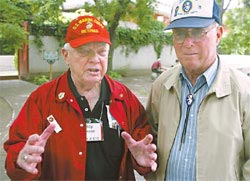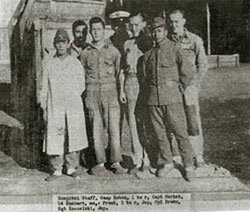| Home / Living in China / Life in Pictures | Tools: Save | Print | E-mail | Most Read |
| Unforgettable Brutality a Legacy of Captivity |
| Adjust font size: |
It's been 65 years since Roy Weaver was taken prisoner and thrown into a Japanese-run POW camp in "The worst part, I think, was never knowing when you were going to get out," Weaver, 88, said yesterday of the former Mukden POW camp, in
Roy Weaver (left), 88, and Robert A. Brown, 82, former WWII prisoners held in a Japanese POW camp in Shenyang, outside their Beijing hotel yesterday. He is among nine former American prisoners of war and 47 spouses or family members of deceased soldiers and sponsors currently on a short visit to It is the first time such a large POW delegation has ever visited the site. Washington DC-based Truth Council for World War II in Today the site is a museum under construction, dedicated to the memory of those who were incarcerated there, and will officially open in September at a cost of 54 million yuan (US$7 million), funded by the Shenyang, Liaoning and central governments. The remains of the World War II prison camp, located in Northeast China, was where more than 2,000 allied forces, most of them American, were imprisoned between November 1942 and August 1945 by the Japanese. The site was left to deteriorate until a few years ago. Tortured by vicious beatings, "bacteria experiments", hunger and other harsh treatment, hundreds of prisoners died there during those years. Some historians considered the camp one of the Japanese forces' most brutal. Before they checked into During the first bitterly cold winter, many men died and couldn't be buried because the ground was frozen, he recalled. In the spring more than 200 bodies were awaiting burial. "The ground was frozen solid. We couldn't dig graves so we couldn't bury anybody," Weaver, of
Robert A. Brown (third from left) at the Japanese camp. "So we put the bodies in a warehouse -- they were frozen -- and we stacked them like wood. And then in the spring time, when we could bury them, we brought them all out at the same time and buried them." Like many others servicemen, Weaver was captured in the Another former prisoner, Robert A. Brown, 82, of The captain, both Brown and Weaver recalled, used his sword to command obedience from prisoners who did not follow his orders - willingly or innocently. Keeping the blade sheathed, Bull would use the sword as a beating stick. "If you did something wrong you would get beat up," said Brown, who served in the Army Air Corps during World War II. "When we were in formation, if someone at the end of the line did something, he would charge at you and unbuckle his sword while walking. When he got down there the guys would melt like butter. He was big, mean and ugly." Weaver took a few of Bull's blows and now suffers from severe arthritis in one shoulder and even had to undergo surgery to fix the damage of one of Bull's violent rampages. For other visitors, like Janiece Cohen, the trip to the museum site was a chance to learn about a horrible period in the life of a loved one. Cohen, a Continental Airlines flight attendant from "I realized there were so many questions that I had," she said about his detention. "My father was very closed up emotionally." One thing he shared with her involved the "medical experiments" of which details remain a mystery even today, as both the Japanese and American governments have been tightlipped about the claims. Her father, Ray Cohen, spoke about Japanese doctors arriving at the camp in white suits and injecting him and other prisoners who later became ill, she said. She has no doubts the Japanese conducted the experiments, she theorized was possible malaria drug testing. "He was injected with something and it made him sick," she said. "He didn't know what it was. And in the camp, doctors would come in with their white robes and watch. So I know it's true." Many group members on this trip, including Cohen, brought old uniforms, postcards and artifacts, which they donated to the new museum. They are also helping museum researchers piece together vital information about the prison camp. The site was first considered as a potential museum more than four years ago following a visit by former American prisoners who lobbied officials to preserve the Since then, the city government of The renovated site will include all the remaining site buildings - a two-storey brick building, three bungalows and a water tower. There will be an outdoor square with two walls inscribed with the names of POWs held there. The Mukden camp site is widely regarded as compelling evidence of Many Chinese believe Despite his tender age, Weaver said he wanted to visit "Don't ever forget what happened in the POW camps," Weaver said. "People should remember this, so that way, we don't do it over again." ( |
| Tools: Save | Print | E-mail | Most Read |
 |
| Related Stories |
|

